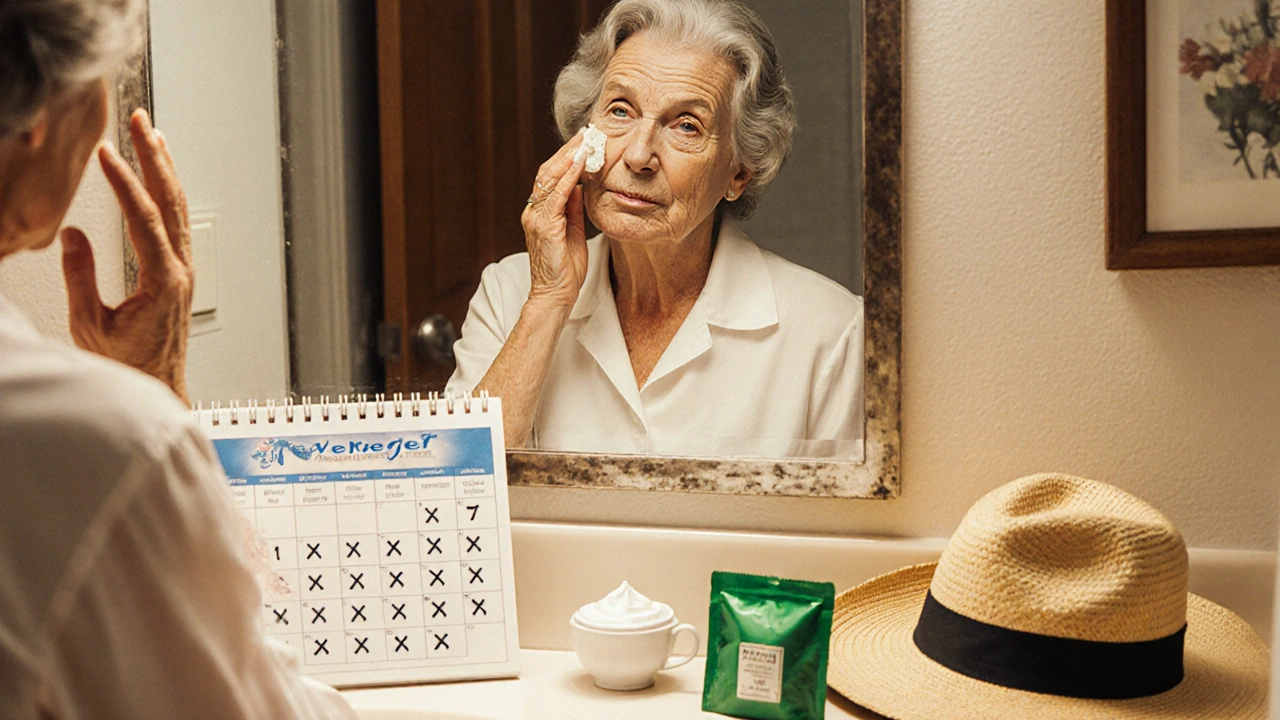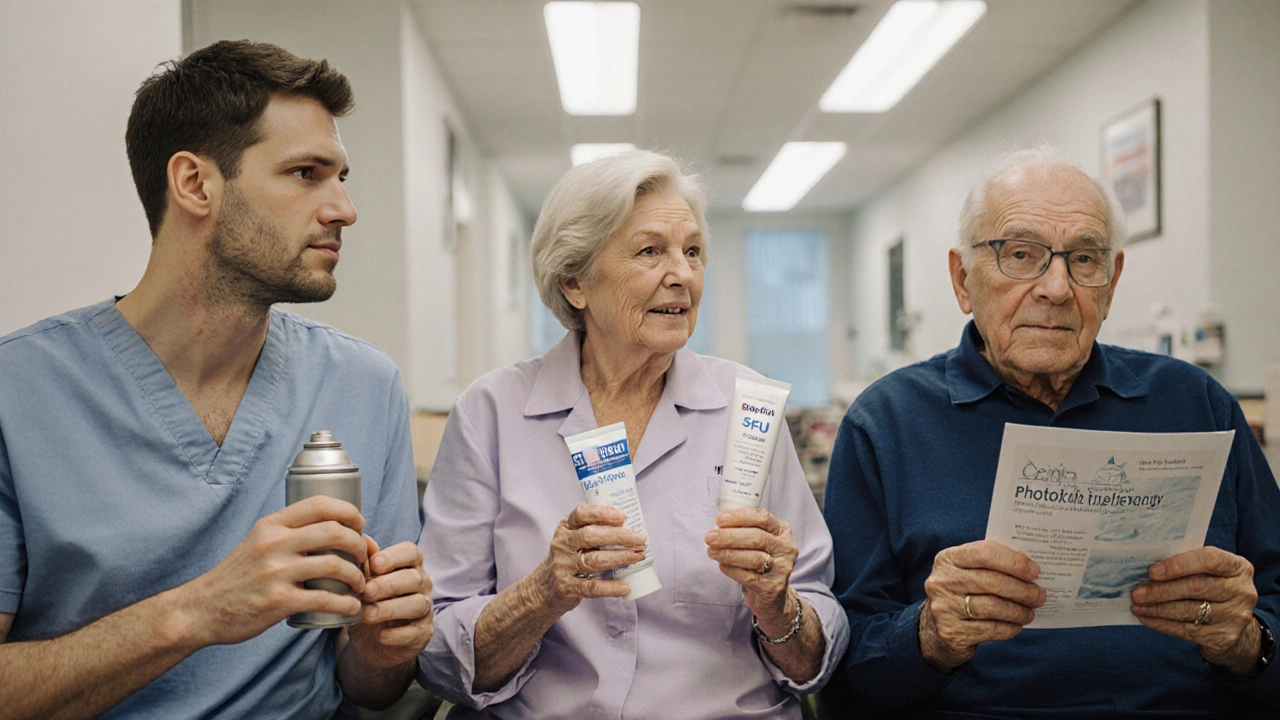Aldara Cream (Imiquimod) vs Alternatives: What Works Best for Skin Conditions

If you’ve been prescribed Aldara Cream (imiquimod), you’re probably trying to figure out if it’s really the best option-or if there’s something else that works just as well, maybe with fewer side effects. You’re not alone. Thousands of people use this cream every year to treat genital warts, actinic keratosis, and even some early skin cancers. But it’s not the only player in the game. So what’s actually better? And more importantly, what’s right for your skin?
What Aldara Cream Actually Does
Aldara Cream contains imiquimod, a topical immune response modifier. It doesn’t kill the virus or cancer cells directly. Instead, it tricks your skin into thinking there’s an infection, which wakes up your immune system to attack the problem. For genital warts caused by HPV, this means your body clears the growths over time. For actinic keratosis (sun-damaged skin patches), it helps destroy abnormal cells before they turn into cancer.
It’s applied three times a week for up to 16 weeks. That’s a long time. And it doesn’t come without drama. Redness, swelling, burning, and flaking are common. Some people get so irritated they stop using it. Others feel embarrassed by the visible skin reactions. It’s effective-but it’s also tough on the skin and the psyche.
Alternative #1: Cryotherapy (Freezing with Liquid Nitrogen)
If you’ve ever had a wart removed at the doctor’s office, you’ve probably seen this. Liquid nitrogen is sprayed onto the lesion, freezing it instantly. The tissue dies, then peels off over the next week or two. It’s fast, cheap, and widely available.
Compared to Aldara, cryotherapy works in fewer visits-often just one or two. No daily cream application. No weeks of red, flaky skin. But it’s not painless. The freeze feels like a sharp sting, and some people get blisters or scarring, especially on the face or genitals. It also doesn’t treat invisible HPV spread the way Aldara does. If you have multiple warts or hidden lesions, cryotherapy might miss some.
Alternative #2: Podophyllotoxin (Condyline)
This is another topical treatment, but it works differently. Instead of boosting your immune system, podophyllotoxin directly stops the wart cells from multiplying. It’s usually applied twice a day for three days, then skipped for four days. That cycle repeats for up to four weeks.
It’s faster than Aldara. Side effects are milder-mostly local irritation. But it’s only approved for genital warts, not actinic keratosis. And you have to be careful: it’s toxic if swallowed or absorbed through large areas of broken skin. Pregnant people can’t use it. It’s also not as good at preventing recurrence. Studies show about 50% of warts come back after podophyllotoxin, compared to 30-40% with imiquimod.
Alternative #3: Sinecatechins (Veregen)
Veregen is a green tea extract cream, approved for genital warts. It’s plant-based, which appeals to people looking for "natural" options. It works by reducing inflammation and blocking the virus from replicating. Applied three times daily for up to 16 weeks.
Side effects are similar to Aldara: redness, itching, burning. But studies show it’s just as effective. One big plus? It doesn’t cause the same level of skin erosion. That means less discomfort and better tolerance. The downside? It’s expensive-often more than Aldara-and not always covered by insurance. Also, it’s only for genital warts. No use for sun damage.

Alternative #4: 5-Fluorouracil (5-FU) Cream
This one’s older. Originally used for skin cancer, 5-FU cream kills fast-growing abnormal cells. It’s commonly used for actinic keratosis, especially when there are lots of lesions spread across the face or scalp.
Applied once or twice daily for 2-4 weeks. It causes intense inflammation-skin turns bright red, crusts over, and peels. Many people describe it as worse than Aldara. But it’s cheaper and often covered by public health plans. It’s also more effective for widespread sun damage. If you have 20+ actinic keratoses on your forehead, 5-FU might clear them faster than Aldara.
But it’s not for everyone. People with sensitive skin or those who can’t tolerate heavy irritation often quit. And unlike Aldara, it doesn’t boost immunity. It just burns off the bad cells. That means a higher chance of recurrence if you keep getting sun exposure.
Alternative #5: Photodynamic Therapy (PDT)
This is a clinic-based treatment. A light-sensitive cream is applied to the skin, then activated with a special red light. It destroys abnormal cells while sparing healthy tissue. Usually done in one or two sessions.
PDT works fast. Results show up in days, not weeks. It’s excellent for large areas of sun damage. Studies show it clears actinic keratosis better than Aldara in the short term. Side effects are mostly pain during the light exposure and temporary redness afterward.
The catch? It’s expensive. You need a specialist, special equipment, and multiple appointments. Insurance doesn’t always cover it unless you’ve tried other options first. And it’s not approved for genital warts. So it’s a great tool-but only for certain cases.
Which One Should You Choose?
There’s no universal best. It depends on what you’re treating, where it is, how much you can tolerate, and what your budget allows.
For genital warts:
- Want something quick? Try cryotherapy.
- Prefer a daily cream? Aldara or Veregen are both solid.
- Want to avoid immune reactions? Podophyllotoxin might be easier.
For actinic keratosis:
- One or two spots? Aldara or cryotherapy.
- Dozens of patches? 5-FU or PDT.
- Want to avoid burning your skin? PDT gives better cosmetic results.
Cost matters too. Aldara can cost over $200 per tube in New Zealand without subsidy. Cryotherapy is often under $50 per session. 5-FU cream? Sometimes less than $30. Veregen? Nearly double the price of Aldara.

What Most People Don’t Tell You
Many people stop using Aldara because they think it’s not working after two weeks. But it takes time. Immune responses don’t happen overnight. If your skin is just starting to get red and flaky, that’s actually a sign it’s working-not failing.
Also, none of these treatments prevent new warts or sun damage. You still need to use condoms, avoid sun exposure, and get regular skin checks. Treatment is just one part of the puzzle.
And if you’re using Aldara for genital warts, your partner should be checked too. HPV spreads easily. Even if your warts disappear, the virus might still be there.
When to Talk to Your Doctor Again
Call your doctor if:
- Your skin becomes severely blistered, oozing, or infected.
- You develop a fever or flu-like symptoms during treatment.
- The lesion grows larger or changes color after starting treatment.
- You’ve finished a full course and nothing changed.
Some lesions don’t respond to any topical treatment. That’s when biopsy or surgical removal becomes necessary. Don’t keep trying the same cream for months if it’s not working.
Final Thoughts
Aldara Cream is a powerful tool, but it’s not the only one. It’s effective, especially for immune-related conditions. But if you can’t handle the irritation, or if you need faster results, alternatives exist that might suit you better.
Don’t just stick with what your doctor first suggested. Ask about other options. Bring up cost. Ask about side effects you’re worried about. Your skin, your life, your choice.
Is Aldara Cream better than freezing for genital warts?
It depends. Freezing (cryotherapy) works faster and needs fewer visits, but it only treats visible warts. Aldara helps your immune system clear hidden HPV, reducing recurrence. If you have multiple warts or are worried about them coming back, Aldara may be more effective long-term. But if you want quick results and can handle the discomfort of freezing, cryotherapy is a solid choice.
Can I use Aldara Cream on my face?
Yes, but with caution. Aldara is approved for actinic keratosis on the face and scalp. But the skin there is thinner and more sensitive. Side effects like redness, peeling, and burning can be severe. Many doctors recommend 5-FU or photodynamic therapy for facial lesions because they’re more predictable and cause less long-term irritation.
How long does it take for Aldara to work?
It varies. For genital warts, you might start seeing changes in 4-6 weeks, but full clearance can take up to 16 weeks. For actinic keratosis, results often appear after 8-12 weeks. Don’t give up if you don’t see results in the first two weeks. The immune response takes time to build.
Is Veregen safer than Aldara?
In terms of skin irritation, yes. Veregen (green tea extract) causes less severe skin erosion and flaking than Aldara. Both cause redness and burning, but Veregen’s reactions tend to be milder. However, it’s not safer overall-it’s still a potent treatment. Neither is recommended during pregnancy, and both require careful application to avoid spreading to healthy skin.
Can I buy Aldara Cream without a prescription?
No. Aldara Cream is a prescription-only medication in New Zealand and most countries. Even if you find it online without a script, it’s risky. Counterfeit versions exist, and using it incorrectly can cause serious skin damage. Always get it from a licensed pharmacy with a doctor’s recommendation.